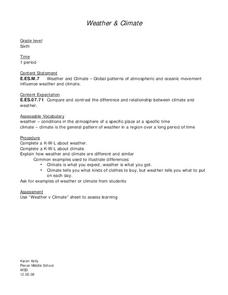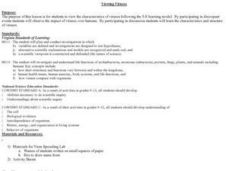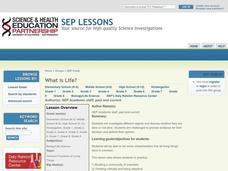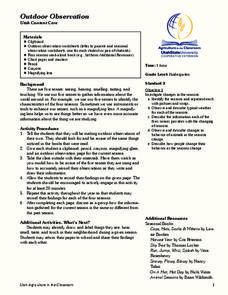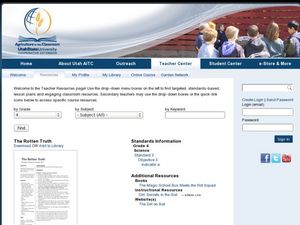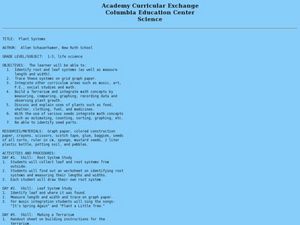Curated OER
Comparing Apples and Onions
Fifth graders observe heredity. In this Science lesson, 5th graders are introduced to the concept of traits being passed from parents to offspring. Students investigate the concepts through apples and onions.
Curated OER
Microbes and Health
Sixth graders investigate microorganisms. In this Science lesson, 6th graders examine how microorganisms can be both positive and negative. Students list diseases caused by microorganisms.
Curated OER
Weather & Climate
Sixth graders differentiate weather and climate. In this earth science lesson, 6th graders complete a KWL chart about the two. They complete a worksheet by identifying whether a certain statement describes weather or climate.
Curated OER
Weather: Like It or Not!
Second graders investigate daily weather changes. In this earth science lesson, 2nd graders identify the different terms used to describe weather. They use the outdoor thermometer to record data.
Curated OER
Dark Days
Fourth graders investigate the impacts of erosion. In this Science lesson, 4th graders determine connections between plants and soil erosion. Students examine the historical implications of erosion.
Curated OER
Keeping Soil in Its Place
Fourth graders investigate erosion. In this Science lesson, 4th graders explore the role of weathering and plant growth related to erosion. Students define the components of soil. Students explore the history of the Dust Bowl.
Curated OER
The Soil Chain
Fourth graders show the needs of plants met by soil. In this Science lesson, 4th graders detail the components of soil and determine which are living or once living and non-living. Students determine the needs of plant growth that are...
Curated OER
Mining and Land Reclamation - A Classroom Simulation
Students simulate mining mineral resources using cookies. In this earth science lesson, students analyze the cost and profits in mining. They write a lab report about the activity.
Curated OER
Viewing Viruses
Pupils view the characteristics of viruses following the 5-E learning model. By participating in discrepant events Students observe the impact of viruses over humans. By participating in discussion pupils examine the characteristics and...
Curated OER
What is Matter?
Learners create a definition of matter. In this physical science lesson, students work in pairs to sort items printed on cards into several categories (matter, non-matter, and unsure) and agree on a definition of matter.
Curated OER
Nutrition Awareness
High schoolers gain an awareness of nutrition. For this science lesson plan, students explore how to determine his or her ideal body weight, demonstrate familiarity with the food groups relating to kilocaloric content, estimate the basic...
Curated OER
Fling It
Students investigate the best design using technology. In this science lesson, students construct a freestanding object with specific materials to be able to shoot a ping pong ball and a marshmallow. They have to adjust and...
Curated OER
Mud Splat Craters
Students simulate crater formation using mud. For this earth science lesson, students identify the features of a crater. They explain how the force of impact affect the crater's appearance.
Curated OER
What is Life?
Learners investigate the characteristics of living things. In this life science lesson, students examine several living and non-living specimens. Learners determine which things are living and non-living.
Curated OER
Outdoor Observation
Students use observation materials to record what they find outdoors. In this senses lesson plan, students use their five senses to observe things outside. They use a clipboard, pencil, crayons, magnifying glass, and their senses to find...
Curated OER
Why is There a Tidal Bulge Opposite the Moon?
Students simulate how the Moon causes ocean tides. In this earth science lesson, students calculate gravitational acceleration using a mathematical formula. They compare the force of attraction between the Earth, Moon and Sun system.
Curated OER
States of Matter
Students explore the states of water. In this physical science instructional activity, students use ice and dry ice to observe the changes in the state of matter. Students record the results.
Curated OER
Vegetable Twister
Second graders study the changes in organisms over time. In this Life Science lesson, 2nd graders explore how living things react to changes in the environment. Students identify the basic needs of living things.
Curated OER
The Rotten Truth
Fourth graders investigate compost. In this Science lesson, 4th graders take notes on the components of soil and its relation to plant growth. Students describe the steps in making compost.
Curated OER
The Celestial Sphere and Circumpolar Motion
Students investigate the celestial sphere and circumpolar motion. In this science lesson, students view an applet, The Celestial Sphere and Circumpolar Motion. Students discuss the Earth's rotation and stellar movement.
Curated OER
Plant Systems
Students examine plant systems. For this life science lesson, students explore leaf and root systems on paper in a terrarium that they design and construct.
Curated OER
Earth Turns? Prove It!
Young scholars construct a pendulum using a washer and thin fishing line. In this earth science lesson, students simulate Earth's rotation using the pendulum bob and swivel chair. They explain how this activity proves that the Earth is...
Curated OER
Norman Suburban Activity
Students analyze the factors affecting organisms in the pond ecosystem. In this environmental science lesson, students perform an experiment to determine pH, nutrients and temperature of different pond sites. They present their result to...
Curated OER
Wolf Communications Matching Activity
Students complete several activities to learn about wolves. In this wolf science lesson, students read and complete activities to learn about wolf communication, their life cycle, fun facts, and hunting activities. Students also read...


